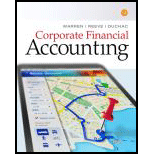
Corporate Financial Accounting
14th Edition
ISBN: 9781305653535
Author: Carl Warren, James M. Reeve, Jonathan Duchac
Publisher: Cengage Learning
expand_more
expand_more
format_list_bulleted
Question
Chapter 14, Problem 14.2EX
1.
To determine
Vertical Analysis
Vertical analysis is prepared to analyze the relationship among various financial statements with a particular base amount.
Formula:
This analysis is otherwise called as common-size statement.
To prepare: Comparative income statement for the two-year period.
Given info: Income statement for the two year period
2.
To determine
To comment: Significant relationships revealed by the vertical analysis.
Expert Solution & Answer
Trending nowThis is a popular solution!

Students have asked these similar questions
Why is the economic order quantity?
Analysts are projecting that Capital Railways will have earnings per share of $4.20. If the average industry P/E ratio is 22, what is the current price of Capital Railways? Could you help me solve this financial accounting question using appropriate calculation techniques?
Calculate the beginning inventory?
Chapter 14 Solutions
Corporate Financial Accounting
Ch. 14 - Briefly explain the difference between liquidity,...Ch. 14 - What is the advantage of using comparative...Ch. 14 - Prob. 3DQCh. 14 - How would the current and quick ratios of a...Ch. 14 - Prob. 5DQCh. 14 - What do the following data, taken from a...Ch. 14 - A. How does the rate earned on total assets differ...Ch. 14 - Kroger, a grocery store, recently had a...Ch. 14 - Prob. 9DQCh. 14 - Prob. 10DQ
Ch. 14 - Horizontal analysis The comparative accounts...Ch. 14 - Vertical analysis Income statement information for...Ch. 14 - Current position analysis The following items are...Ch. 14 - Accounts receivable analysis A company reports the...Ch. 14 - Inventory analysis A company reports the...Ch. 14 - Prob. 14.6BECh. 14 - Prob. 14.7BECh. 14 - Asset turnover A company reports the following:...Ch. 14 - Prob. 14.9BECh. 14 - Common stockholders' profitability analysis A...Ch. 14 - Earnings per share and price-earnings ratio A...Ch. 14 - Vertical analysis of income statement Revenue and...Ch. 14 - Prob. 14.2EXCh. 14 - Common-sized income statement Revenue and expense...Ch. 14 - Vertical analysis of balance sheet Balance shed...Ch. 14 - Horizontal analysis of the income statement Income...Ch. 14 - Current position analysis The following data were...Ch. 14 - Prob. 14.7EXCh. 14 - Current position analysis The bond indenture for...Ch. 14 - Accounts receivable analysis The following data...Ch. 14 - Accounts receivable analysis Xavier Stores Company...Ch. 14 - Inventory analysis The following data were...Ch. 14 - Inventory analysis QT, Inc. and Elppa Computers,...Ch. 14 - Ratio of liabilities to stockholders' equity and...Ch. 14 - Prob. 14.14EXCh. 14 - Ratio of liabilities to stockholders' equity and...Ch. 14 - Prob. 14.16EXCh. 14 - Profitability ratios The following selected data...Ch. 14 - Profitability ratios Ralph Lauren Corporation...Ch. 14 - Six measures of solvency or profitability The...Ch. 14 - Five measures of solvency or profitability The...Ch. 14 - Earnings per share, price-earnings ratio, dividend...Ch. 14 - Prob. 14.22EXCh. 14 - Earnings per share, discontinued operations The...Ch. 14 - Prob. 14.24EXCh. 14 - Unusual items Explain whether Colston Company...Ch. 14 - Comprehensive Income Anson Industries, Inc....Ch. 14 - Horizontal analysis of income statement For 20V2,...Ch. 14 - Prob. 14.2APRCh. 14 - Prob. 14.3APRCh. 14 - Measures of liquidity, solvency, and profitability...Ch. 14 - Solvency and profitability trend analysis Addai...Ch. 14 - Horizontal analysis of income statement For 20Y2,...Ch. 14 - Prob. 14.2BPRCh. 14 - Effect of transactions on current position...Ch. 14 - Measures of liquidity, solvency and profitability...Ch. 14 - Solvency and profitability trend analysis Crosby...Ch. 14 - Financial Statement Analysis The financial...Ch. 14 - Prob. 14.1ADMCh. 14 - Deere: Profitability analysis Deere Company...Ch. 14 - Marriott and Hyatt: Solvency and profitability...Ch. 14 - Prob. 14.1TIFCh. 14 - Prob. 14.3TIF
Knowledge Booster
Similar questions
- Calculate the holding period return? Accounting questionarrow_forwardDuring 2018, the band Maroon 5 is touring across the U.S. on its "Red Pill Blues Tour 2018." Two of those concerts, on October 14 and 15, will be held at Madison Square Garden in New York City. Madison Square Garden has a seating capacity for concerts of approximately 19,000. According to a Business Insider article in December 2016, Maroon 5 had an average concert ticket price of $165.Assume that these two Madison Square Garden concerts were sold out on the first day the tickets were available for sale to the public, November 4, 2017. Also assume, for the sake of simplicity, that all tickets are sold directly by Maroon 5.Question:How much gross concert revenue will Maroon receive for the two Madison Square Garden concerts?arrow_forwardPlease explain this financial accounting problem by applying valid financial principles.arrow_forward
- The actual cost of direct labor per hour is $22 and the standard cost of direct labor per hour is $25. The direct labor hours allowed per finished unit is 0.5 hours. During the current period, 4,800 units of finished goods were produced using 2,400 direct labor hours. How much is the direct labor rate variance? A. $7,200 favorable B. $7,200 unfavorable C. $14,400 favorable D. $14,400 unfavorablearrow_forwardCalculate the holding period return?arrow_forwardLaura estimates that his car costs $290 per month in fixed expenses, such as insurance and registration. Additionally, he calculates gas, oil, and maintenance at 16 cents per mile. Laura typically drives 1,250 miles each month on average. How much would Laura expect his total car costs to be in May if he drives 1,680 miles?arrow_forward
arrow_back_ios
SEE MORE QUESTIONS
arrow_forward_ios
Recommended textbooks for you
 Managerial AccountingAccountingISBN:9781337912020Author:Carl Warren, Ph.d. Cma William B. TaylerPublisher:South-Western College Pub
Managerial AccountingAccountingISBN:9781337912020Author:Carl Warren, Ph.d. Cma William B. TaylerPublisher:South-Western College Pub Corporate Financial AccountingAccountingISBN:9781337398169Author:Carl Warren, Jeff JonesPublisher:Cengage Learning
Corporate Financial AccountingAccountingISBN:9781337398169Author:Carl Warren, Jeff JonesPublisher:Cengage Learning Financial AccountingAccountingISBN:9781337272124Author:Carl Warren, James M. Reeve, Jonathan DuchacPublisher:Cengage Learning
Financial AccountingAccountingISBN:9781337272124Author:Carl Warren, James M. Reeve, Jonathan DuchacPublisher:Cengage Learning Managerial Accounting: The Cornerstone of Busines...AccountingISBN:9781337115773Author:Maryanne M. Mowen, Don R. Hansen, Dan L. HeitgerPublisher:Cengage Learning
Managerial Accounting: The Cornerstone of Busines...AccountingISBN:9781337115773Author:Maryanne M. Mowen, Don R. Hansen, Dan L. HeitgerPublisher:Cengage Learning

Managerial Accounting
Accounting
ISBN:9781337912020
Author:Carl Warren, Ph.d. Cma William B. Tayler
Publisher:South-Western College Pub

Corporate Financial Accounting
Accounting
ISBN:9781337398169
Author:Carl Warren, Jeff Jones
Publisher:Cengage Learning

Financial Accounting
Accounting
ISBN:9781337272124
Author:Carl Warren, James M. Reeve, Jonathan Duchac
Publisher:Cengage Learning

Managerial Accounting: The Cornerstone of Busines...
Accounting
ISBN:9781337115773
Author:Maryanne M. Mowen, Don R. Hansen, Dan L. Heitger
Publisher:Cengage Learning